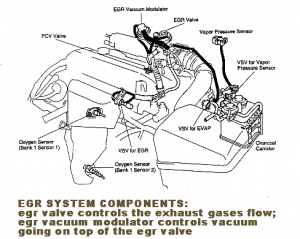P0400 Code Definition
- Exhaut Gas Recirculation Flow Malfunction

Symptoms:
- Check Engine Light will illuminate
- In most cases, there are no adverse conditions noticed by the driver
- In some cases, there may be performance problems, such as pinging on acceleration, when the engine is under load or when driving the vehicle at higher speeds
Analysis:
- Restriction in the EGR passages, usually caused by carbon buildup
- The EGR Valve is defective
- Lack of proper vacuum or electrical signal to the EGR valve
- Excessive Vacuum flow to EGR valve
- Malfunctioning EGR Vacuum supply solenoid
- Lack of proper EGR system feedback to the computer from the:
- Manifold Absolute Pressure Sensor (MAP)
- Differential EGR Pressure Feedback Sensor (DPFE)
- EGR Valve Position Sensor (EVP)
- EGR Temperature Sensor
The Basics
The exhaust gas recirculation (EGR) system recycles a small amount of exhaust gas from the exhaust system (usually no more than 10 percent) and mixes it with the intake manifold air entering into the combustion chambers. The addition of this inert (or non-combustible) exhaust gas limits the peak combustion temperatures to a range that is below 2500° F, where the formation of nitrogen oxide (NOx) is know to occur. In some cases where the engine is pinging and/or knocking badly from a severe lack of EGR flow, misfires can take place which allow raw hydrocarbons (HC) to be released from the tailpipe.
P0400 Diagnostic Code:
EGR monitoring criteria are a set of test values and are usually run during at least two different driving conditions—steady speed freeway driving and steady speed city driving.
The engine control module determines proper EGR flow in many ways:
- Temperature increase in the EGR passages when the EGR is supposed to be flowing
- Measurable amount of Manifold Pressure change when the EGR is supposed to be flowing
- Measurable change (usually a decrease) in the front Oxygen Sensor Signal
- Position change in the EGR valve as measured by an EGR Valve Position Sensor
- Amount of Spark Knock as measured by the Knock Sensor
- Amount of decrease in exhaust back pressure as measured by the Digital EGR Pressure Feedback Sensor
The P0400 code is often not a problem with the EGR valve itself. Rather, the EGR system is not allowing enough EGR to flow back into the combustion process to sufficiently cool the peak firing temperatures, or too much EGR may be flowing. Once the code P400 has been retrieved with a scan tool, the freeze frame data should be documented and analyzed in order to determine what engine conditions were present when the code was triggered. It is recommended that the vehicle be driven in such a way as to duplicate the code setting conditions with a data streaming scan tool connected, so the behavior of the EGR actuating components and feedback sensors can be monitored.
Likely Problem:
- Does the engine die, not just stumble, when the EGR valve is manually raised to its maximum?
(Use either a vacuum pump or bi-directional scan tool if it’s a digital EGR valve.) - Is the EGR valve getting sufficient vacuum? (Use the manufacturer EGR vacuum spec.)
- Is the EGR system restricted? (The engine stumbles, but does not die.)
- Is the EGR system plugged? (Engine RPM does not change.)
- Does the EGR valve work?
- Raise the RPM to 3000 and check manifold vacuum. Then open the EGR valve to its maximum—the manifold vacuum should drop by at least 3″ of mercury. If it does not, there is a flow and/or restriction problem.
- Test the EGR temperature sensor (if equipped) with a propane torch and a DVOM.
- Test the accuracy of the EGR valve position sensor with a scan tool or DVOM by raising or lowering the EGR valve.
- Test the Digital EGR Pressure Feedback Sensor (DPFE) with a data streaming scan tool to verify that the voltage or lift percentage changes according to spec.
- Verify that the front Oxygen Sensor readings drop and the Short Term Fuel Trim increases when the EGR valve opens. (EGR leans out the mixture.)
Tech Notes:
If the NOx goes down when the EGR valve is raised (this test is most commonly performed on a Dynamometer), it is likely that one or more EGR passages or cylinders are plugged or very restricted, making the EGR only go to one or two cylinders. When this occurs, you may notice misfires and even have misfire codes along with the P0400. This can occur on vehicles that use EGR “runners” for each cylinder.